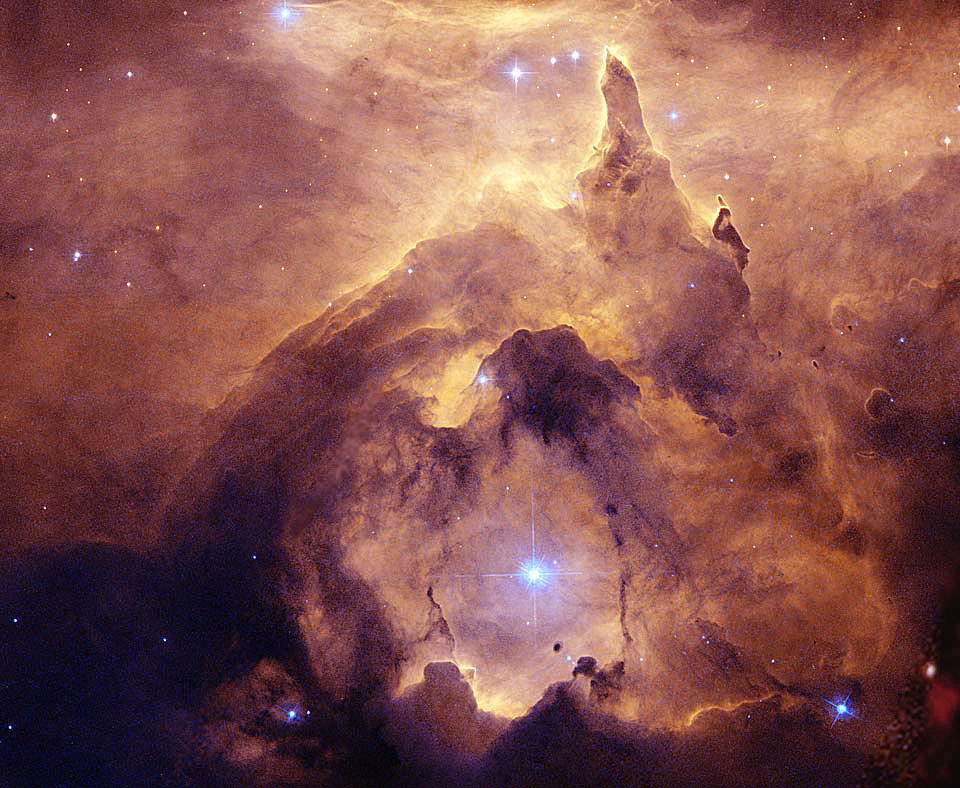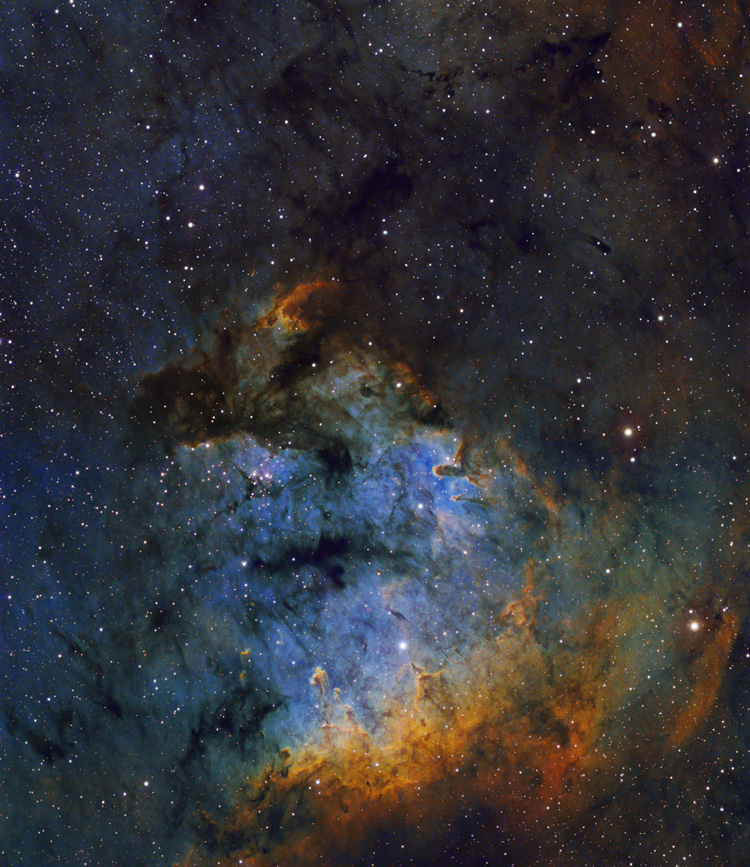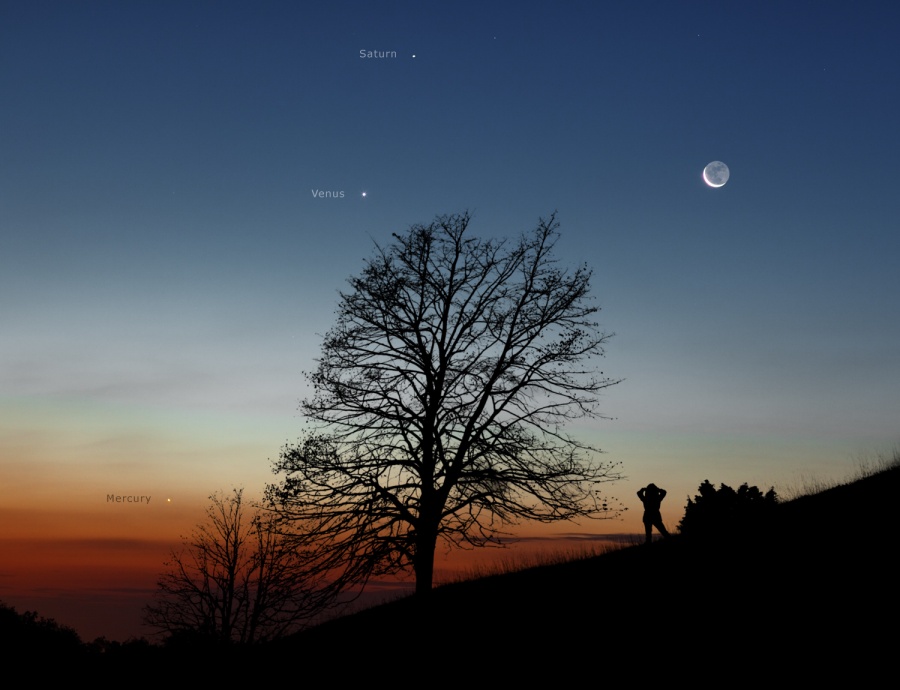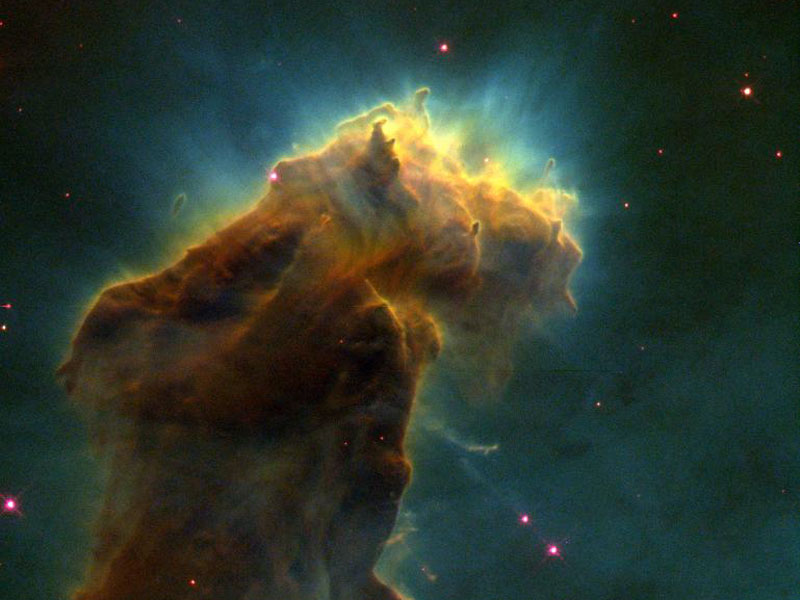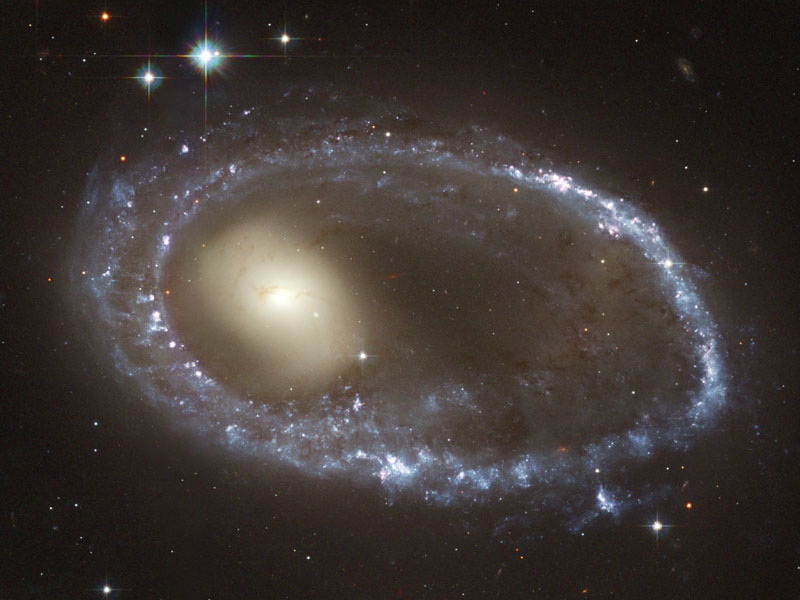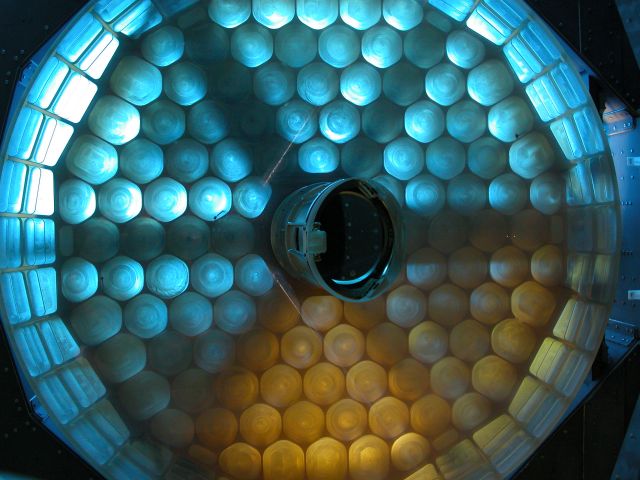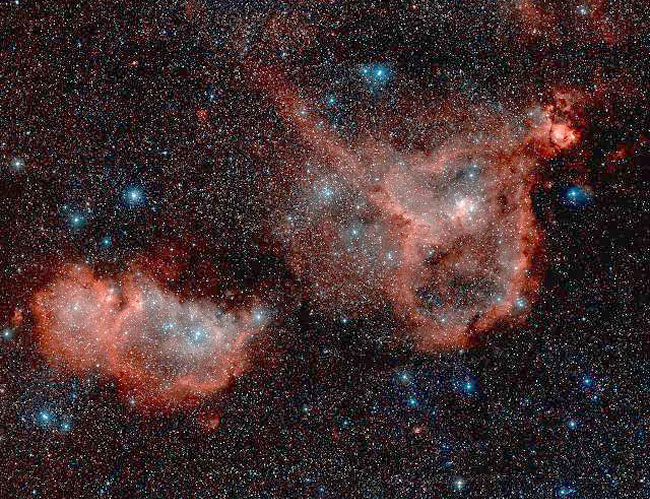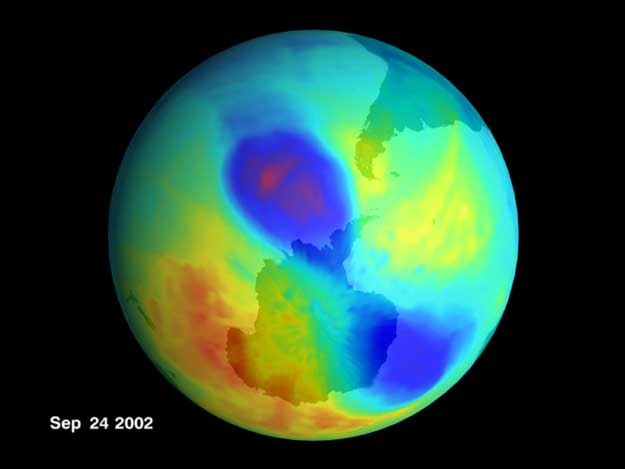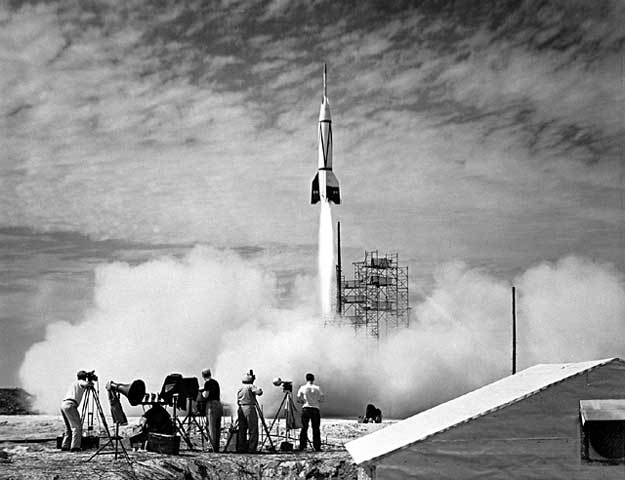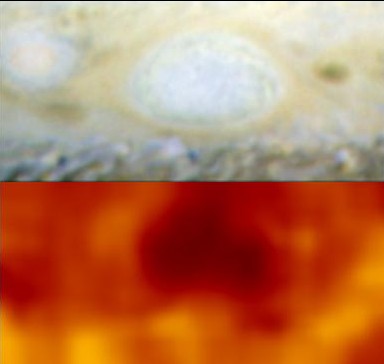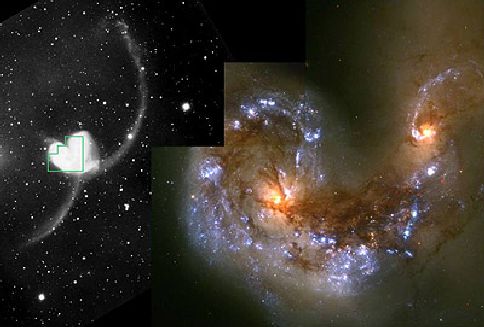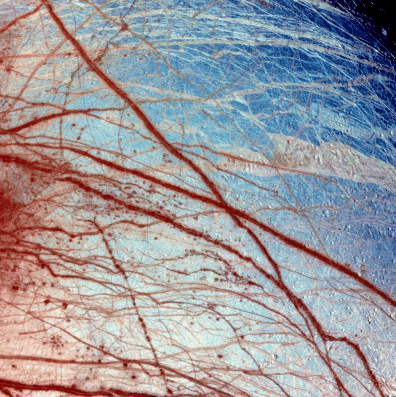| << Previous | Index | Next >> |
2014
Click to play embedded YouTube video.
Image Credit: Solar Dynamics Observatory, NASA
2013 For reasons unknown, NGC 6357 is forming some of the most massive stars ever discovered. One such massive star, near the center of NGC 6357, is framed above carving out its own interstellar castle with its energetic light from surrounding gas and dust. In the greater nebula, the intricate patterns are caused by complex interactions between interstellar winds, radiation pressures, magnetic fields, and gravity. The overall glow of the nebula results from the emission of light from ionized hydrogen gas. Near the more obvious Cat's Paw nebula, NGC 6357 houses the open star cluster Pismis 24, home to many of these tremendously bright and blue stars. The central part of NGC 6357 shown spans about 10 light years and lies about 8,000 light years away toward the constellation of the Scorpion.
2012
Click to play embedded YouTube video.
Credit & Copyright: Bryan Chan, Los Angeles Times; Music: Keeper of the Wind (Eleni Hassabis, Firstcom)
2011 On October 29 (UT), Jupiter, the solar system's largest planet, will be at opposition, opposite the Sun in planet Earth's sky, shining brightly and rising as the Sun sets. That configuration results in Jupiter's almost annual closest approach to planet Earth, so near opposition the gas giant offers earthbound telescopes stunning views of its stormy, banded atmosphere and large Galilean moons. This sharp snapshot of Jupiter was captured on October 13 with the 1 meter telescope at the Pic Du Midi mountain top observatory in the French Pyrenees. North is up in the image that shows off oval shaped vortices and planet girdling dark belts and light zones. Also seen in remarkable detail, Jupiter's icy Ganymede, the solar system's largest moon, is emerging from behind the planet (top) while volcanic Io enters the frame near the lower left edge.
2010 Pillars of gas, dust, and young, hot stars seem to fill the gaping maw of NGC 7822. At the edge of a giant molecular cloud toward the northern constellation Cepheus, the glowing star forming region lies about 3,000 light-years away. Within the nebula, bright edges and dark shapes are highlighted in this colorful skyscape. The image includes data from both broadband and narrowband filters, mapping emission from atomic oxygen, hydrogen, and sulfur into blue, green, and red hues. The atomic emission is powered by the energetic radiation from the hot stars, whose powerful winds and radiation also sculpt and erode the denser pillar shapes. Stars could still be forming inside the pillars by gravitational collapse, but as the pillars are eroded away, any forming stars will ultimately be cutoff from their reservoir of star stuff. This field spans around 60 light-years at the estimated distance of NGC 7822.
2009 Last Friday, a gathering of three bright planets and the Moon graced the morning sky. With Mercury, Venus, Saturn, and a narrow lunar crescent close to the eastern horizon in the dawn twilight, this picture of the beautiful conjunction was recorded near Noerdlingen, Germany. These planets are wandering apart now and Mercury is sinking closer toward the rising Sun. But if you also scan the rest of the sky this week you should be able to add Jupiter and Mars to your planet spotting list, as Mars rises around midnight and Jupiter shines brightly after sunset. In fact, if you want a better view of Jupiter than Galileo had, you might check out the 2009 International Year of Astronomy activities and events during these next few Galilean Nights (October 22-24).
2008 A favorite target for astronomers, big, beautiful spiral galaxy NGC 7331 is one of the brighter galaxies not found in Charles Messier's famous 18th century catalog. About 50 million light-years distant in the northern constellation Pegasus and similar in size to our own Milky Way Galaxy, NGC 7331 is often imaged as the foreground of a visual grouping that includes an intriguing assortment of background galaxies some ten times farther away. This striking image of the well-studied island universe and environs was produced using data from the Calar Alto Observatory in southern Spain. Perhaps the deepest view of the region yet, the image data were processed to reveal sharp details of all sizes in both bright and faint areas. A color balance was chosen so that white would be the result of averaging colors over the entire galaxy. The result shows off a wealth of remarkable features in NGC 7331 and its surroundings.
2007 Scroll right to see the largest crater yet visited by a rover on Mars. Reaching the expansive Victoria Crater has been a goal for the robotic Opportunity rover rolling across Mars for the past two years. Victoria crater has about five times the diameter of Endurance Crater, which Opportunity spent six months exploring. Opportunity reached Victoria last year, and was cautiously probing the edges of the stadium-sized crevice while waiting for large dust storms to clear. A safe path was found, and Opportunity has slowly entered into Victoria Crater. It is hoped that Victoria Crater will show a deep stack of layers uncovered by the initial impact, and hence new clues into the ancient surface history of Mars. Visible in the distance in the above mosaic is the far rim of Victoria Crater, lying about 800 meters away and rising about 70 meters above the crater floor. The alcove in front has been dubbed Duck Bay.
2006 Where do stars form? One place, star forming regions known as "EGGs", are uncovered at the end of this giant pillar of gas and dust in the Eagle Nebula (M16). EGGs, short for evaporating gaseous globules, are dense regions of mostly molecular hydrogen gas that fragment and gravitationally collapse to form stars. Light from the hottest and brightest of these new stars heats the end of the pillar and causes further evaporation of gas - revealing yet more EGGs and more young stars. This picture was taken by the Wide Field and Planetary Camera on board the Hubble Space Telescope.
2005 How could a galaxy become shaped like a ring? The rim of the blue galaxy pictured on the right is an immense ring-like structure 150,000 light years in diameter composed of newly formed, extremely bright, massive stars. That galaxy, AM 0644-741, is known as a ring galaxy and was caused by an immense galaxy collision. When galaxies collide, they pass through each other -- their individual stars rarely come into contact. The ring-like shape is the result of the gravitational disruption caused by an entire small intruder galaxy passing through a large one. When this happens, interstellar gas and dust become condensed, causing a wave of star formation to move out from the impact point like a ripple across the surface of a pond. The intruder galaxy has since moved out of the frame taken by the Hubble Space Telescope and released to commemorate the anniversary of Hubble's launch in 1990. Ring galaxy AM 0644-741 lies about 300 million light years away.
2004 The candy-dish appearance of this high-tech astronomical mirror is striking. Made of a special glass ceramic material called Zerodur, it actually measures 2.7 meters across. The transparent surface has not yet received a reflective coating, so the weight-reducing internal honeycomb structure is visible with attractive blue and yellow tints provided by a protective tarp and background lighting. Recently unveiled, the telescope mirror is destined to fly on the Stratospheric Observatory For Infrared Astronomy (SOFIA). Since water vapor in Earth's troposphere tends to block infrared light, SOFIA will operate from a modified Boeing 747 jetliner at altitudes above 40,000 feet. As the largest airborne observatory in the world, SOFIA will explore a host of cosmic environments including sites of star birth and death, the formation of distant solar systems, and black holes in active galaxies.
2003 Is the heart and soul of our Galaxy located in Cassiopeia? Possibly not, but that is where two bright emission nebulas nicknamed Heart and Soul can be found. The Heart Nebula, officially dubbed IC 1805 and visible above on the right, has a shape reminiscent of a classical heart symbol. Both nebulas shine brightly in the red light of energized hydrogen. Several young open clusters of stars populate the image and are visible above in blue, including the nebula centers. Light takes about 6,000 years to reach us from these nebulas, which together span roughly 300 light years. Studies of stars and clusters like those found in the Heart and Soul Nebulas have focussed on how massive stars form and how they affect their environment.
2002 As expected, the ozone hole near Earth's South Pole is back again this year. This time, however, it's smaller than the past two years, and has an unusual double lobe structure. Ozone is important because it shields us from damaging ultraviolet sunlight. Ozone is vulnerable, though, to CFCs and halons being released into the atmosphere. International efforts to reduce the use of these damaging chemicals appear to be having a positive effect on their atmospheric abundance. The smaller size of the ozone hole this year, however, is attributed mostly to warmer than normal air in the surrounding stratosphere. The above picture of the ozone hole was taken on September 24 by TOMS on board the orbiting Earth Probe satellite.
2001 A new chapter in space flight began on 1950 July with the launch of the first rocket from Cape Canaveral, Florida: the Bumper 2. Shown above, the Bumper 2 was an ambitious two-stage rocket program that topped a V-2 missile base with a WAC Corporal rocket. The upper stage was able to reach then-record altitudes of almost 400 kilometers, higher than even modern Space Shuttles fly today. Launched under the direction of the General Electric Company, the Bumper 2 was used primarily for testing rocket systems and for research on the upper atmosphere. Bumper 2 rockets carried small payloads that allowed them to measure attributes including air temperature and cosmic ray impacts. Seven years later, the Soviet Union launched Sputnik I and Sputnik II, the first satellites into Earth orbit. In response, in 1958, the US created NASA.
2000 Many stars like our Sun were formed in open clusters. The above open cluster, M11, contains thousands of stars and is just over three thousand light years distant. The stars in this cluster all formed together about 150 million years ago. The bright young stars in M11 appear blue. Open clusters, also called galactic clusters, contain fewer and younger stars than globular clusters. Also unlike globular clusters, open clusters are generally confined to the plane of our Galaxy. M11 is visible with binoculars towards the constellation of Scutum.
1999 While hunting for meteors in the night sky above the White Mountains near Bishop, California, astrophotographer James Young instead captured this brilliant celestial apparition. Recorded near twilight on August 13, the bright streak is not the flash of a meteor trail but sunlight glinting from a satellite. The satellite, Iridium 52, is one of a constellation of Iridium digital communication satellites in Earth orbit known for producing stunning, predictable "flares" as they momentarily reflect sunlight from shiny antenna surfaces. For well placed observers, the peak brightness of this Iridium satellite flare reached about -6 magnitude, not quite as bright as the half illuminated moon. At magnitude 2.5, the bright star at the left is Alpha Pegasi, a star in the constellation Pegasus.
1998 Sometime in February, two of three long-lived Jovian storm systems known as "white ovals" apparently collided and merged -- forming what is now likely the second largest storm in the Solar System, after the famous Great Red Spot. The whitish, oval-shaped storms in Jupiter's banded atmosphere have been telescopically studied since the 1930s, but details of this surprising merger are unknown as Jupiter and Earth were on opposite sides of the Sun when it happened. The aftermath is shown in the (top panel) Hubble Space Telescope picture, taken in July as part of the evidence investigators are using to reconstruct the facts of the case. Centered are the swirling white clouds of the newly created storm system which is about as wide as planet Earth. At its left is the remaining smaller white oval which seems to be drifting away from the larger new storm. Atmospheric temperature data from the Galileo spacecraft represented in the (bottom panel) false-color image show the new storm as a dark feature, cooler than its surroundings.
1997 A ground-based telescopic view (left) of the collision between the galaxies NGC4038 and NGC4039 reveals long arcing insect-like "antennae" of luminous matter flung from the scene of the accident. Investigators using the Hubble Space Telescope to sift through the cosmic wreckage near the two galaxy cores have recently announced the discovery of over a thousand bright young clusters of stars - the result of a burst of star formation triggered by the collision. The green outline shows the area covered by the higher resolution Hubble image (right). At the distance of the Antennae galaxies (about 63 million light-years), a pixel in this image corresponds to about 15 light-years. Dust clouds around the two galactic nuclei give them a dimmed and reddened appearance while the massive, hot, young stars of the newly formed clusters are blue. How do colliding galaxies evolve with time? Determining the ages of star clusters formed in galaxy collisions can provide significant clues. The Antennae galaxies are seen in the southerly constellation Corvus.
1996 What caused the cracks in this giant ice-ball? Jupiter's moon Europa has smoothest surface in the solar system and is composed mostly of cracked water-ice. In the above false-colored picture released last week by the NASA team in charge of the Galileo mission, blue hues represent ice plains divided by dirty red and brown bands of mottled terrain. As the robot Galileo spacecraft orbits Jupiter, it sends back revealing pictures of Jupiter and its large moons including Europa, Io, Ganymede, and Callisto. The region of Europa highlighted above is known as Minos Linea. The cause for many of the cracks remains unknown but may involve shifting stresses from gravity and temperature variations. The new Galileo pictures have increased evidence that liquid oceans may indeed exist under these giant ice-sheets, a place possibly ripe for the development of life.
1995 In 1963 astronomers were astounded to discover that certain faint, star-like objects have very large redshifts. The large redshifts imply that these objects, now known as quasars (QUASi-stellAR objects), lie near the edge of the observable Universe. To be visible at such extreme distances of billions of light years, they must emit tremendous amounts of energy. Where does the energy come from? In the most widely accepted model, a quasar is the bright nucleus of an active galaxy powered by a central, supermassive black hole. This Hubble Space Telescope image shows a quasar known as PKS 2349 (the star-like object near the center) and a galaxy (surrounding fuzzy patch), but the quasar is not at the galaxy's center! In fact, the galaxy and quasar seem to be colliding or merging. This and other recent HST observations suggest that astronomers' standard ideas about quasars may be wrong.
| << Previous | Index | Next >> |
